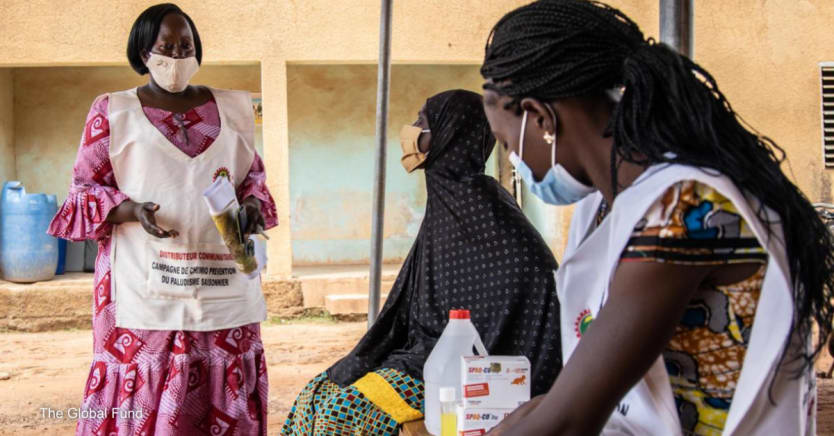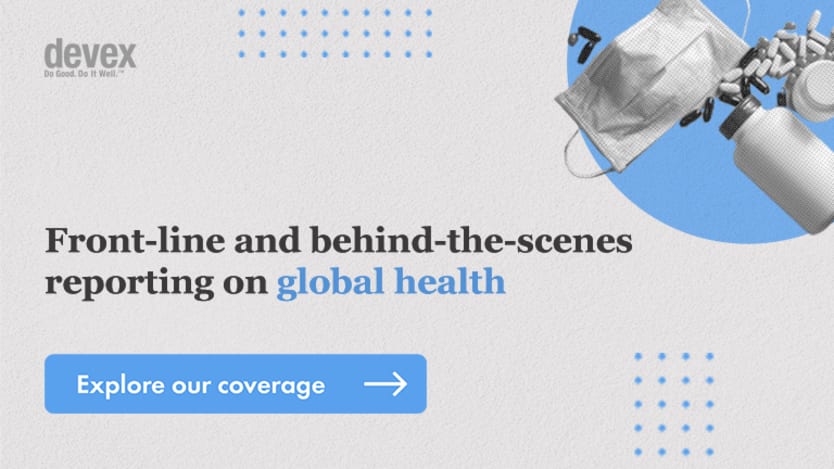
The COVID-19 pandemic has exposed flaws in the ability of our global health architecture to prevent and respond to pandemic threats. In a momentous evolution, which may have gone unnoticed amid other debates, the Global Fund to Fight AIDS, Tuberculosis and Malaria made pandemic preparedness and response part of its evolving mandate upon adopting its new strategy in November.
The World Health Organization, the World Bank, bilateral donors, and others have crucial roles to play, but the Global Fund — if it adapts to the challenge — could change empty promises on preparedness into a safer world.
Sign up for Devex CheckUp
The must-read weekly newsletter for exclusive global health news and insider insights.
Accountable, technically sound, country-level mechanisms are needed to channel resources for strengthening preparedness to low- and middle-income countries. The Global Fund has excelled in its efforts to end AIDS, TB, and malaria due to its wide-ranging support from bilateral donors, including the United States; buy-in from countries at all income levels; extensive footprint; inclusive and accountable governance; and tested mechanisms that deploy resources effectively within nations.
As the host of the Global Fund’s seventh replenishment and its largest funder, the U.S. government should request at least $3 billion for the organization in its budget proposal for fiscal year 2023, with $1 billion per year dedicated to a new funding envelope for preparedness. The U.S. could indicate a preference for this to be provided via a financial intermediary fund at the World Bank — but also indicate that regardless of whether such a fund is established in time, the country is committed to giving these resources to the Global Fund.
A financial intermediary fund may not become operational in a time frame that enables co-financing requirements and country preparedness allocations. A down payment from the U.S. would catalyze global progress, mobilizing other donors and generating $3 billion per year via the usual 2-to-1 match requirement that the U.S. places on its Global Fund allocations.
This would take the world much of the way toward closing the gap in funding — estimated at $5 billion to $10 billion per year — needed to reduce the risks of the next pandemic threat in low- and middle-income countries. What’s more, even without such a threat, these funds would save lives and promote economic stability in lower-income countries. And funders could track — objectively — how effective these funds are at speeding up the discovery of and response to health threats.
Some of the Global Fund’s previous crosscutting activities and investments in AIDS, TB, and malaria initiatives have contributed to the broader objective of advancing health security. In the past year, the organization has demonstrated its ability to support countries in mitigating COVID-19’s impact on programs to fight HIV, TB, and malaria, as well as to respond effectively to the pandemic and initiate urgent improvements in health and community systems against new disease threats.
The Global Fund is well positioned to strengthen pandemic preparedness and response. Nonetheless, it must take five steps to maximize the likelihood of success. If the U.S. commits to a pandemic preparedness window, it can insist on these changes.
1. Adjust governance
The Global Fund’s board of directors, technical review panels, and grant approval committee have brought together scientific, program, and operational experts in AIDS, TB, and malaria; strengthening health and community systems; and strategic investment for impact. These platforms will need to be bolstered with specialists who are well versed in preparedness and response and who can expertly guide, oversee, and assess related investments.
Building on promising experiences of aligning so-called country coordinating mechanisms with national COVID-19 responses, country entities will need to structure their preparedness window to link to existing health security governance mechanisms that are attached to joint external evaluations and national action plans for health security.
Global Fund governance within countries will also have to establish a broader concept of vulnerable populations. In terms of preparedness, the most vulnerable groups are ones alienated from the government or from health services, whether by geography, demographics, or politics. Unless preparedness encompasses all communities, disease emergence and spread cannot be stopped.
2. Focus on value added
The Global Fund has made initial forays in pandemic preparedness and response. With additional resources, it could further reduce infectious disease threats, building off and reinforcing its work around AIDS, TB, and malaria, as well as leveraging its distinctive strength in engaging communities.
Some possible areas of expansion include investment in health workforce development; more accurate and timely systems for surveillance, analysis, communication, and response to ongoing and emerging threats; specimen transport systems and the use of polyvalent diagnostic platforms; improvement to laboratory infrastructure; and quantification of and access to needed commodities.
3. Protect pandemic preparedness and response funds
To prevent weakening the Global Fund’s historical mandate, its board should consider ensuring sustained support for AIDS, TB, and malaria, with funding for the three diseases not to be spent on activities solely related to pandemic preparedness. This is particularly important amid setbacks in progress in these areas due to COVID-19.
But if it is serious about making meaningful advances in pandemic preparedness, the Global Fund’s board must also carve out money for preparedness — which is needed for core health security activities to get adequately funded — and be prepared to deploy response funds, whatever the next threat may be. This could be achieved through the creation of a catalytic fund alongside country allocations and a distinct mechanism for response funds.
4. Hire staffers for expertise
Just as the Global Fund’s governance should evolve to match its new activities, staffing at its secretariat must evolve to ensure sufficient technical capacity in preparedness and response to support country requests for investment in these areas. The Global Fund’s operations during the pandemic, which saw deepened collaboration with specialist organizations, offer a useful precedent.
5. Strengthen key partnerships
As the Global Fund expands its activities in pandemic preparedness and response, an essential step will be to align and work closely with WHO — and particularly its Health Emergencies Programme, which collaborates with countries and partners to help build core capacities to rapidly detect, respond to, and recover from health threats.
The Global Fund should complement — and not attempt to replace — WHO’s technical guidance, which has been strong during the COVID-19 pandemic and must become even stronger and faster in the months and years ahead for a broad array of health threats.
It should also strengthen partnerships with development banks, which are uniquely positioned to provide foundational financing through initiatives such as the World Bank’s Regional Disease Surveillance Systems Enhancement Program. The World Bank encourages government-owned and prioritized investment, laying the groundwork for complementary Global Fund programming.
And just as many Global Fund programs are facilitated by important resources and technical strengths from the U.S. President's Emergency Plan for AIDS Relief, the Global Fund will need to work with bilateral donors and nongovernmental organizations to ensure that investments remain strategic, accountable, and technically robust.
The Global Fund is a proven mechanism to attract substantial funding, with more than $50 billion disbursed as of 2021. The organization catalyzes donors to invest alongside the U.S. and provide $2 for every $1 from the U.S. The organization has also shown that it can allocate funds equitably according to need and promote effective use by more than 120 countries.
Although improvements at WHO and increased investments in the Coalition for Epidemic Preparedness Innovations and other entities are also important, a Global Fund that is well resourced and appropriately organized can be the game changer that the world needs, accelerating country efforts that will greatly decrease the likelihood of another pandemic as disruptive as COVID-19.










